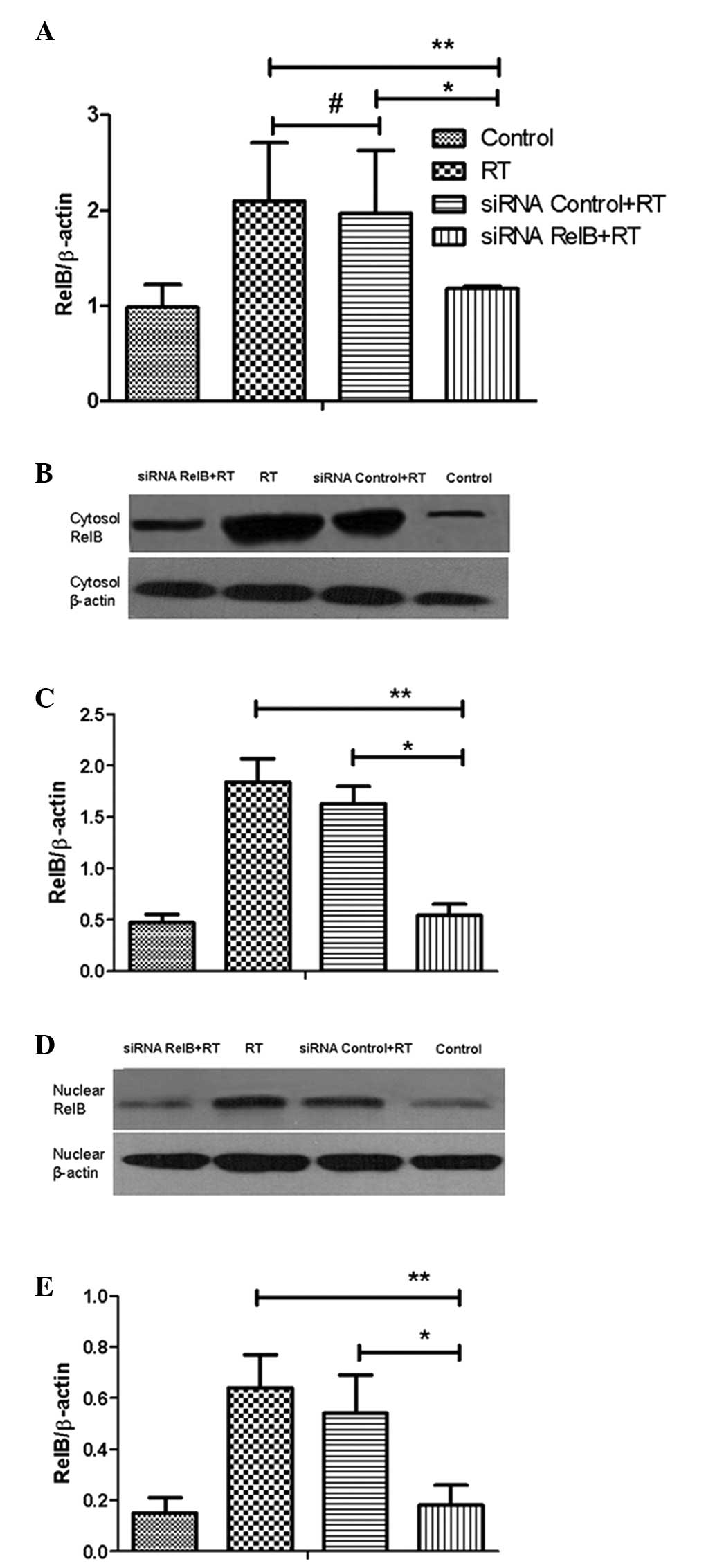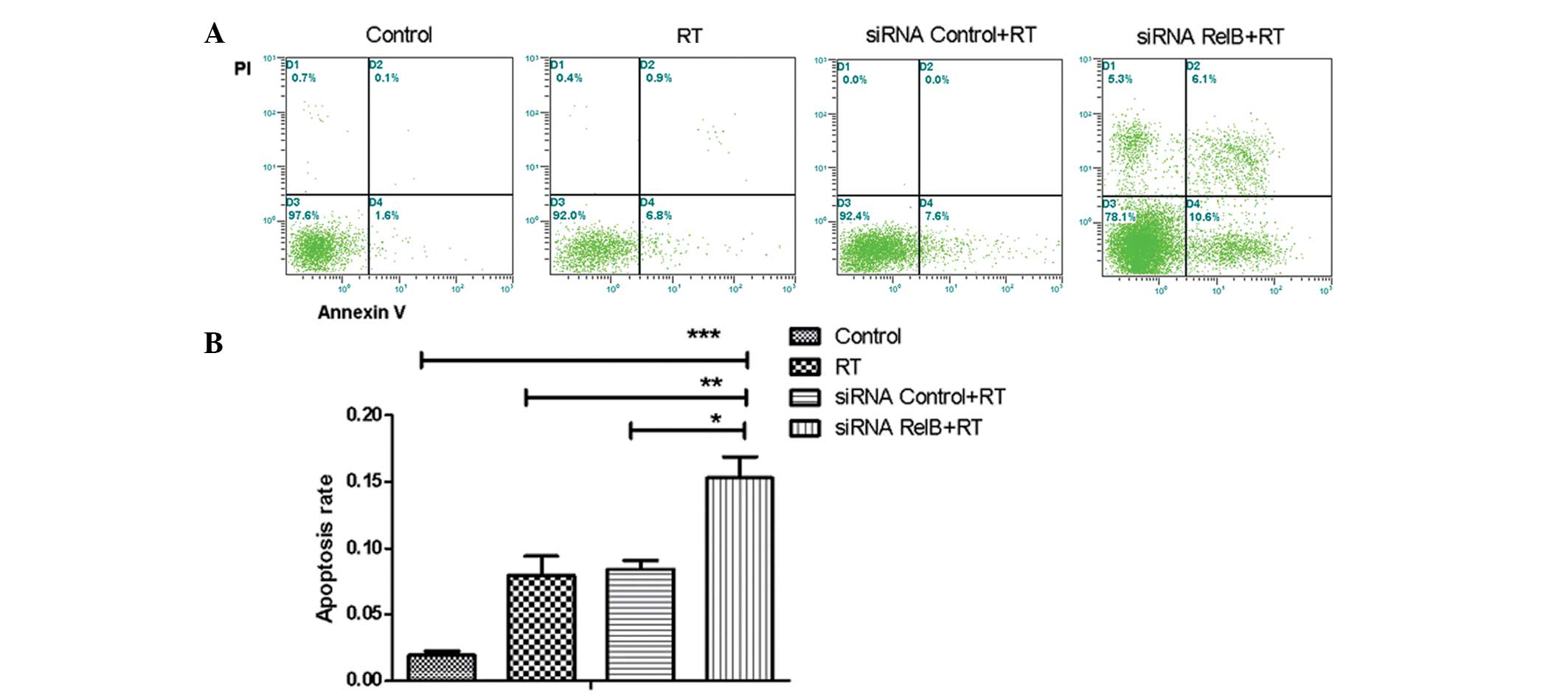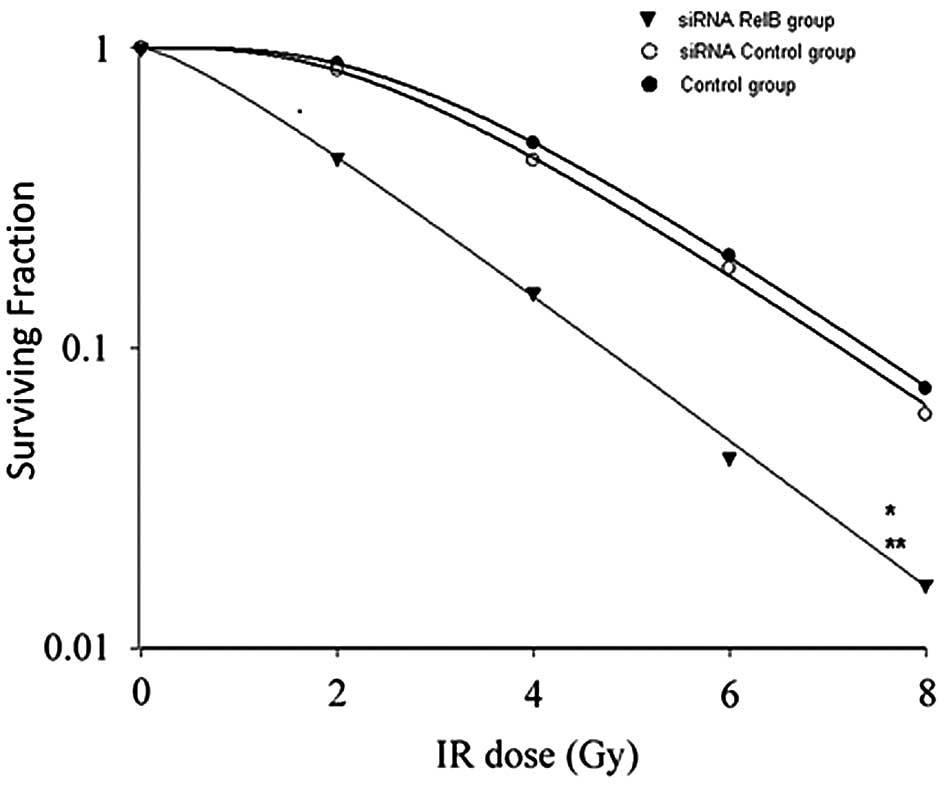|
1
|
Brawley OW: Prostate cancer epidemiology
in the United States. World J Urol. 30:195–200. 2012. View Article : Google Scholar : PubMed/NCBI
|
|
2
|
Shao Q, Ouyang J, Fan Y, et al: Prostate
cancer in the senior men from rural areas in east district of
China: contemporary management and 5-year outcomes at
multi-institutional collaboration. Cancer Lett. 315:170–177. 2012.
View Article : Google Scholar
|
|
3
|
Fitzgerald TJ, Wang T, Goel HL, et al:
Prostate carcinoma and radiation therapy: therapeutic treatment
resistance and strategies for targeted therapeutic intervention.
Expert Rev Anticancer Ther. 8:967–974. 2008. View Article : Google Scholar : PubMed/NCBI
|
|
4
|
Criswell T, Leskov K, Miyamoto S, et al:
Transcription factors activated in mammalian cells after clinically
relevant doses of ionizing radiation. Oncogene. 22:5813–5827. 2003.
View Article : Google Scholar : PubMed/NCBI
|
|
5
|
Seo SI, Song SY, Kang MR, et al:
Immunohistochemical analysis of NF-kappaB signaling proteins
IKKepsilon, p50/p105, p52/p100 and RelA in prostate cancers. APMIS.
117:623–628. 2009. View Article : Google Scholar : PubMed/NCBI
|
|
6
|
Perkins ND and Gilmore TD: Good cop, bad
cop: the different faces of NF-κB. Cell Death Differ. 13:759–772.
2006. View Article : Google Scholar : PubMed/NCBI
|
|
7
|
Enzler T, Sano Y, Choo MK, et al:
Cell-selective inhibition of NF-κB signaling improves therapeutic
index in a melanoma chemotherapy model. Cancer Discov. 1:496–507.
2011. View Article : Google Scholar
|
|
8
|
Umezawa K: Possible role of peritoneal
NF-κB in peripheral inflammation and cancer: lessons from the
inhibitor DHMEQ. Biomed Pharmacother. 65:252–259. 2011. View Article : Google Scholar : PubMed/NCBI
|
|
9
|
Lessard L, Begin LR, Gleave ME, et al:
Nuclear localisation of nuclear factor-kappaB transcription factors
in prostate cancer: an immunohistochemical study. Br J Cancer.
93:1019–1023. 2005. View Article : Google Scholar : PubMed/NCBI
|
|
10
|
Murley JS, Kataoka Y and Cao D: Delayed
radioprotection by NFkappaB-mediated induction of Sod2 (MnSOD) in
SA-NH tumor cells after exposure to clinically used
thiol-containing drugs. Radiat Res. 162:536–546. 2004. View Article : Google Scholar : PubMed/NCBI
|
|
11
|
Xu Y, Josson S, Fang F, Oberley TD, et al:
RelB enhances prostate cancer growth: implications for the role of
the nuclear factor-kappaB alternative pathway in tumorigenicity.
Cancer Res. 69:3267–3271. 2009. View Article : Google Scholar : PubMed/NCBI
|
|
12
|
Heng-cheng TT, Liu XH, Kuang YU, et al:
Construction and identification of mouse RelB siRNA-expressing
lentiviral vectors. Sci Res Essays. 6:777–783. 2011.
|
|
13
|
Chendil D, Das A, Dey D, et al: Par-4, a
pro-apoptotic gene, inhibits radiation-induced NF kappa B activity
and Bcl-2 expression leading to induction of radiosensitivity in
human prostate cancer cells PC-3. Cancer Biol Ther. 1:152–160.
2002. View
Article : Google Scholar : PubMed/NCBI
|
|
14
|
Okera M, Bae K, Bernstein E, et al:
Evaluation of nuclear factor kappaB and chemokine receptor CXCR4
co-expression in patients with prostate cancer in the Radiation
Therapy Oncology Group (RTOG) 8610. BJU Int. 108:E51–E58. 2011.
View Article : Google Scholar
|
|
15
|
Holley AK, Xu Y, St Clair DK and St Clair
WH: RelB regulates manganese superoxide dismutase gene and
resistance to ionizing radiation of prostate cancer cells. Ann N Y
Acad Sci. 1201:129–136. 2010. View Article : Google Scholar : PubMed/NCBI
|
|
16
|
Hanahan D and Weinberg RA: Hallmarks of
cancer: the next generation. Cell. 144:646–674. 2011. View Article : Google Scholar : PubMed/NCBI
|
|
17
|
Watson C, Miller DA, Chin-Sinex H, et al:
Suppression of NF-kappaB activity by parthenolide induces X-ray
sensitivity through inhibition of split-dose repair in TP53 null
prostate cancer cells. Radiat Res. 171:389–396. 2009. View Article : Google Scholar : PubMed/NCBI
|
|
18
|
Bischoff P, Altmeyer A and Dumont F:
Radiosensitising agents for the radiotherapy of cancer: advances in
traditional and hypoxia targeted radiosensitisers. Expert Opin Ther
Pat. 19:643–662. 2009. View Article : Google Scholar : PubMed/NCBI
|
|
19
|
Carlson DJ, Yenice KM and Orton CG: Tumor
hypoxia is an important mechanism of radioresistance in
hypofractionated radiotherapy and must be considered in the
treatment planning process. Med Phys. 38:6347–6350. 2011.
View Article : Google Scholar : PubMed/NCBI
|
|
20
|
Yacoub A, Miller A, Caron RW, et al:
Radiotherapy-induced signal transduction. Endocr Relat Cancer.
13:S99–S114. 2006. View Article : Google Scholar
|
|
21
|
Koterba K, Beckman MJ and Gewirtz DA: A
switch between cytoprotective and cytotoxic autophagy in the
radiosensitization of breast tumor cells by chloroquine and vitamin
D. Horm Cancer. 2:272–285. 2011. View Article : Google Scholar : PubMed/NCBI
|
|
22
|
Klokov D, Criswell T, Leskov KS, Araki S,
Mayo L and Boothman DA: IR-inducible clusterin gene expression: a
protein with potential roles in ionizing radiation-induced adaptive
responses, genomic instability, and bystander effects. Mutat Res.
568:97–110. 2004. View Article : Google Scholar : PubMed/NCBI
|
|
23
|
Simon EL, Goel HL, Teider N, et al: High
dose fractionated ionizing radiation inhibits prostate cancer cell
adhesion and beta(1) integrin expression. Prostate. 64:83–91. 2005.
View Article : Google Scholar : PubMed/NCBI
|
|
24
|
Tang CH and Tsai CC: CCL2 increases MMP-9
expression and cell motility in human chondrosarcoma cells via the
Ras/Raf/MEK/ERK/NF-κB signaling pathway. Biochem Pharmacol.
83:335–344. 2012. View Article : Google Scholar
|
|
25
|
Zhu L, Zhu B, Yang L, Zhao X, Jiang H and
Ma F: RelB regulates Bcl-xl expression and the irradiation-induced
apoptosis of murine prostate cancer cells. Biomed Rep. 3:354–358.
2014.
|
|
26
|
Umemura N, Zhu J, Mburu YK, et al:
Defective NF-κB signaling in metastatic head and neck cancer cells
leads to enhanced apoptosis by double-stranded RNA. Cancer Res.
72:45–55. 2012. View Article : Google Scholar :
|
|
27
|
Pradhan M, Baumgarten SC, Bembinster LA,
et al: CBP mediates NF-κB-dependent histone acetylation and
estrogen receptor recruitment to an estrogen response element in
the BIRC3 promoter. Mol Cell Biol. 32:569–575. 2012. View Article : Google Scholar :
|
|
28
|
Josson S, Xu Y, Fang F, et al: RelB
regulates manganese superoxide dismutase gene and resistance to
ionizing radiation of prostate cancer cells. Oncogene.
25:1554–1559. 2006. View Article : Google Scholar
|
|
29
|
Xu Y, Fang F, St Clair DK, et al:
Suppression of RelB-mediated manganese superoxide dismutase
expression reveals a primary mechanism for radiosensitization
effect of 1alpha,25-dihydroxyvitamin D(3) in prostate cancer cells.
Mol Cancer Ther. 6:2048–2056. 2007. View Article : Google Scholar : PubMed/NCBI
|
|
30
|
Xu Y, Fang F, St Clair DK, et al: SN52, a
novel nuclear factor-kappaB inhibitor, blocks nuclear import of
RelB:p52 dimer and sensitizes prostate cancer cells to ionizing
radiation. Mol Cancer Ther. 7:2367–2376. 2008. View Article : Google Scholar : PubMed/NCBI
|
|
31
|
Reuter S, Charlet J, Juncker T, et al:
Effect of curcumin on nuclear factor kappaB signaling pathways in
human chronic myelogenous K562 leukemia cells. Ann N Y Acad Sci.
1171:436–447. 2009. View Article : Google Scholar : PubMed/NCBI
|














